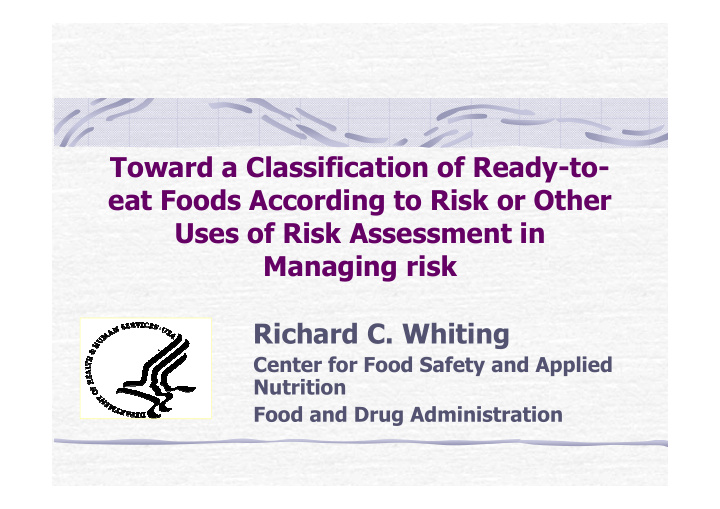



Toward a Classification of Ready-to- eat Foods According to Risk or Other Uses of Risk Assessment in Managing risk Richard C. Whiting Center for Food Safety and Applied Nutrition Food and Drug Administration
Cluster Analysis Risk per Serving Risk per Annum Cluster 1 Cluster A Deli Meats Deli Meats Frankfurters, not reheated Cluster B Pâté and Meat Spreads High Fat and Other Dairy Products Unpasteurized Fluid Milk Frankfurters, not reheated Smoked Seafood Pasteurized Fluid Milk Soft Unripened Cheese Cluster 2 Cooked RTE Crustaceans Cluster C High Fat and Other Dairy Products Cooked RTE Crustaceans Pasteurized Fluid Milk Fruits Soft Unripened Cheese Pâté and Meat Spreads Unpasteurized Fluid Milk Cluster 3 Smoked Seafood Deli-type Salads Dry/Semi-dry Fermented Sausages Cluster D Fresh Soft Cheese Deli-type Salads Frankfurters, reheated Dry/Semi-dry Fermented Sausages Fruits Frankfurters, reheated Preserved Fish Fresh Soft Cheese Raw Seafood Semi-Soft Cheese Semi-soft Cheese Soft Ripened Cheese Soft Ripened Cheese Vegetables Vegetables Cluster E Cluster 4 Cultured Milk Products Cultured Milk Products Hard Cheese Ice Cream and Frozen Dairy Products Ice Cream and Frozen Dairy Products Processed Cheese Preserved Fish Hard Cheese Processed Cheese Raw Seafood
The Model as a Tool Sensitivity Analyses— ’What-If’ Scenarios Estimate the impact of intervention strategies by changing 1 or more input parameters and measuring change in the model output Test effects of changes in process or regulation (prediction of impact on public health) Show how different factors interrelate (hypothetical)
Contamination at Retail Deli Meat - Elderly Predicted Annual Mortality 350 300 250 200 150 100 50 0 1 2 3 4 5 0 6 Log Reduction Achieved by Intervention With baseline storage times and temperatures Growth supporting food
Inhibiting Growth in Frankfurters-Not reheated Growth permitted Growth inhibited (baseline RA) 6.5 x 10 - 8 8.2 x 10 - 10 Cases per serving (median, total population) Cases per annum 30.5 0.4 (median, total population)
‘What-if’ Scenario for Mortality as a Function of Home Storage Time Deli Meat - Elderly 350 Truncated 15 days 300 Frequency 250 Annual Mortality 200 150 Baseline 100 50 0 5 10 15 20 25 30 0 0 5 10 15 20 25 30 Storage time (d) Maximum Storage Time (Days)
Mortality as a Function of Maximum Storage Temperature Deli Meat - Elderly 350 300 Predicted Annual 250 Frequency 7 C/45 F Mortality 200 150 100 50 0 5 10 15 20 0 2 4 6 8 10 12 14 16 Temperature (C) Maximum Refrigerator Temperature (°C)
Conclusions and Interpretations Major factors that affect risk: Susceptibility of individual Frequency and amount of consumption Frequency and level of contamination Ability of food to support growth Opportunity for growth Refrigerated storage temperature Refrigerated storage time
Foods that lead to cases of listeriosis are almost always growth supporting foods with some initial contamination that have been abused It’s not whether a food is below 100 cfu/g or not, the more important question is what is the best public health policy to prevent consumption of 10 4 to 10 6 (or more) cfu/g
Quantitative assessment of relative risk to public health from foodborne Listeria monocytognees among selected categories of ready-to-eat foods. Sept 2003 www.foodsafety.gov
Recommend
More recommend